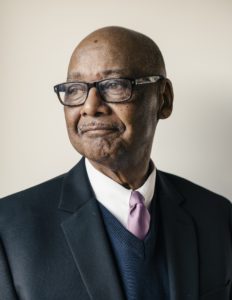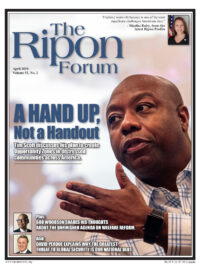
The consensus among both liberal and conservative scholars is that the dissolution of the family structure and function is a major contributor to systemic poverty. Still, in addressing the plight of Americans trapped in intergenerational dependency, neither side explores solutions that go beyond tinkering with the existing 80-plus anti-poverty programs in suggesting reforms of the current welfare system.
The Left argues for more funding and more expansive social safety-net programs, while the Right demands stronger work requirements and drug testing as a condition for receiving aid. Currently, the big push in Congress by the Republican leadership is to consolidate programs and devolve responsibly to states.
Despite all that has been spent over the past 50 years, a recent report by the National Assessment of Educational Progress reveals that a troubling gap between high- and low-achieving students continues to exist. It is widely accepted that the gap is a major contributor to poverty. Many of these documented disparities have a strong implication for race, as low-income black families and children make up a large percentage of those in poverty. Outside factors such as the legacy of discrimination and systemic injustice are always assumed to have resulted in declines within the black community. However, it is useful to look back in recent history to discover successful approaches from the past and how they can be useful in the present day as a foundation for solutions.
Take, as an example, initiatives to close the racial gap in education. In the 1920’s, the gap in educational attainment between black and white males in the South was three years. Blacks had an average of fifth-grade education compared to whites, who had an eighth grade average. By the 1940’s, that gap had closed to just six months — a decline that occurred in an era when local government funding for black schools was a small fraction of that being spent on white schools. This dramatic closing of the educational racial gap was attributed largely to the creation of a collaborative initiative of Booker T. Washington and Julius Rosenwald, the CEO of the Sears Company. Their initiative established 5,000 schools throughout the rural South for which $5 million donated by the philanthropist was matched by contributions from churches, organizations, and individuals within the black community.
In addressing the plight of Americans trapped in intergenerational dependency, neither side explores solutions that go beyond tinkering with the existing 80-plus anti-poverty programs.
From the late 1800s to 1950, some black schools were models of academic achievement. In 1899, black students at Washington DC’s segregated Paul Laurence Dunbar High School outscored white students in the District in citywide tests. Similar strides in academic excellence during that era have been documented for Baltimore’s Frederick Douglass High School, Atlanta’s Booker T. Washington High School, Brooklyn’s Albany Avenue School, and New Orleans’ McDonogh 35 High School. The parents of most of the students who excelled worked as manual laborers, domestic servants, porters and maintenance men, and this record of educational success was accomplished in spite of meager school budgets, second-hand textbooks, and overcrowded classrooms.
The question that begs an answer is, “If Black America could have achieved these gains under such difficult conditions then, why can the same type of gains not be achieved today?” The answer might be found in this famous quote from Rev. Charles Swindoll:
“Life is 10% what happens to me, and 90% how you react to it.”
We are in charge of our attitude. It is more important than the past, than education, than circumstances, than failure, than success, than what people think, say, or do. It is more important than appearance, giftedness, or skill.
History clearly demonstrates that achievements against the scourge of poverty must originate among those experiencing problems. It begins with a belief that self-development is possible, and no matter what their circumstance, they have the capacity to be agents of their own uplift.
Unfortunately, there is no magic policy lever we can pull to eradicate poverty. However, there are effective community-based models that are successfully solving some of our nation’s most intractable problems.
If 70% of black families are raising children who are engaged in self-destructive behavior, it means 30% are not. The Woodson Center goes into these drug-infested crime-ridden neighborhoods and identifies these healthy elements. It then helps to buttress these community anti-bodies with the support that can enable them to become the foundation of an immune system which can restore families and revitalize entire neighborhoods. There are contemporary examples of neighborhoods leaders who are applying the old values of the black community to a new vision.
One such leader was Kimi Gray, a onetime welfare mom who became a national figure because of her efforts to empower residents of public housing. She was a divorced mother of five children in her early twenties living in one of Washington, DC’s most notorious open-air drug markets. Chronically neglected by the D.C. Housing Authority, the residents were often without heat or hot water for weeks at a time. Kimi took on management duties for her development. Within six months, she organized and hired residents and instilled discipline and a sense of hope that revived the entire complex. Even though she was a high school dropout, she managed to send all five of her children off to college. Countless residents sought her help in sending their children to college as well.
As a consequence, Kimi created an initiative called College Here We Come that enabled 600 youths from her public housing development to attain higher education. The initiative made national news. Yet when four of the students came home on semester break, they were ashamed to bring their friends. That set Kimi on a quest to promote improvements in her complex. She was elected resident leader and galvanized the entire neighborhood in a massive restoration effort that drove out the drug dealers and promoted personal responsibility. Kimi’s approach was no-nonsense and entailed high standards. Her efforts virtually wiped out teen pregnancy and helped to make Kenilworth Parkside not only one of the safest places to live, but a place that saw a dramatic reduction in welfare dependency, as well.
Like Kimi, all the grassroots leaders in the Woodson Center’s network began their outreach on the level of vision, values, and character. They also served as models and “surrogate family members” for those who did not come from two-parent households. This is the power of their transforming outreach. Yes, children born to single parents have a greater likelihood of deviant behavior, dropping out of high-school, and living in poverty. But we cannot simply say to them, “Sorry, your parents should have been married.”
Unfortunately, there is no magic policy lever we can pull to eradicate poverty. However, there are effective community-based models that are successfully solving some of our nation’s most intractable problems. To date, deliberating about poverty among liberal and conservative policy experts has been limited to developing a “program” approach. This is an attitude that primarily focuses on externally-imposed related incentives and impediments that are intended to enable individuals and families to ascend out of poverty and ride the wave of the American dream and achieve economic success. The perpetual issue is that such programs do not respect the wisdom and experience of those who have personally overcome poverty and have committed themselves to help others do the same.
Immediate action must be taken in the private sector to invest, bolster, expand, and export effective initiatives that captures the imagination of the American public as well as policymakers. Just as President Obama’s call for support for his My Brothers’ Keeper’s Initiative elicited millions of dollars within a short period, conservatives should be called to provide support and funding for the powerful local initiatives that are based on the founding principles of this country–personal responsibility, self-determination, and mutual assistance.
In the policy arena, action that could be taken to facilitate this renewal and revitalization cannot be dictated from the top-down by analysts and specialists, but must be informed by the experience of the experts who are working on the ground. Experience shows that policy changes will be different in different situations and, typically, will involve the removal of barriers constructed by the government.
Just as Kimi Gray was able to reach and change the lives of hundreds of residents, there are other anti-poverty warriors across the nation performing the life-salvaging tasks of preparing individuals to gain from opportunities to move toward self-sufficiency. What would be the impact if we embraced and supported the work of one thousand Kimi Grays?
Robert L. Woodson, Sr. is the President and Founder of the Woodson Center.




